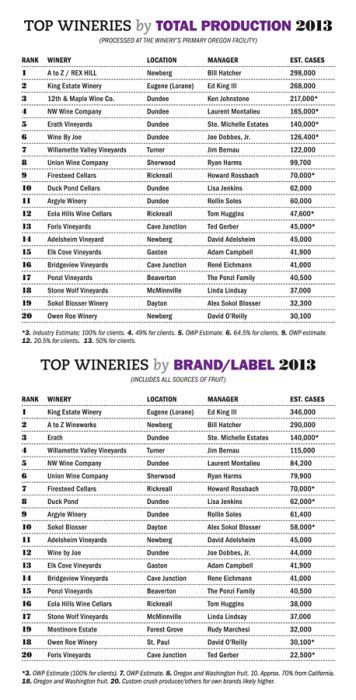Top Production: Oregon's largest facilities report
By Karl Klooster
There were three categories of winegrapes harvest during 2013. Those picked before the monsoons. Those picked during the monsoons. And those picked afterward.
Consequently, there will be notable differences among some 2013 Oregon wines, particularly in the more northerly regions of the state.
According to winemakers, the best of the 2013s are exceptional, perhaps as good as the 2012s. But, at their worst, they are still quite acceptable, once again proving how Oregon vintners adapt to adversity.
Ranked below by quantity of production are Oregon’s 20 largest winery facilities and brands. In other words, some of the largest wineries are not necessarily home to the biggest brands.
At 2.02 million cases, the estimated total production of these 20 wineries represents roughly 65 percent of the state’s total production for 2013, or 3.3 million cases.
How close this yardstick comes to actual production will have to await more definitive information. Last year it was 5.1 percent under.
There is a new numero uno in total production this year. A to Z Wineworks, on Highway 99W just west of Newberg, cranked out 298,000 cases for 2013, leaping over longstanding leader King Estate of Lorane.
However, King Estate retained its top spot as a brand with an estimated production of 346,000 cases carrying the name and related brand names from the 2013 vintage.
Both wineries tallied huge gains over 2012. A to Z’s production soared from 119,300 cases to 298,000, an eye-popping expansion of 149.8 percent.
To retain its No. 1 brand ranking, King Estate jumped from 231,500 cases to 346,000 cases, tallying an impressive 49.5 percent increase.
The total production of the third place winery, 12th & Maple, is purely a matter of conjecture. Its former owner, Precept Wines of Seattle, estimates the winery’s capacity at 217,000 cases, the figure shown here. But for the first time it is strictly an estimate. New owners have declined to release this proprietary information, most likely because the vast majority of production is now for corporate clients.
The Dundee winery appears to have taken over all Erath production formerly done at the Erath Winery on Worden Hill Road in the Dundee Hills. Likewise, the first wines for Kendall-Jackson’s new Oregon affiliate were made there, as well. You might say 12th & Maple has become Oregon’s corporate custom crusher.
Since Erath does not respond to requests either, the 140,000 figure for 2013 is based on a conjecture of growth from 125,000 cases in 2012.
Keep in mind that none of this relates to actual world market conditions. These figures are for the purposes of determining industry growth, evolution and trends.
All the different wines from one vintage would never be sold in a singular calendar year and certainly not in the year they were harvested. Case sales by any given winery in any given year will necessarily be a mix of vintages and types.
Showing continued strength, NW Wine Co., fourth in total production, has built a new winery in Dundee, bought a few hundred more acres in the Eola Hills and increased production from 122,300 cases in 2012 to 165,000 in 2013.
Everybody should watch no-longer-little Union Wine Co. in Tualatin. From 40,000 cases in 2011, to 73,000 in 2012, to 97,900 in 2013, Ryan Harms has something magic up his sleeve — or maybe in a can. Whatever the reason, No. 8 Union Wine is hot on the tails of the big boys.
Looking at the overall harvest picture, the major changes among Oregon’s largest wineries and brands are noted above. The group of prominent players remains essentially the same.
I should mention Copa di Vino apparently produces a significant amount of product at its winery in The Dalles. But where the wine or fruit is from and how the company’s business can be measured in relation to criteria for this report remains a question we have not yet addressed.
Oregon Wine Press strives to make this report as accurate as possible. However, when production drops below the 25,000 to 30,000 case level, a number of wineries are closely clustered and variables can affect their totals.
If any winery qualifying for a place in the 2013 top 20 rankings has been overlooked, please contact us and we will correct the omission in a future issue.









